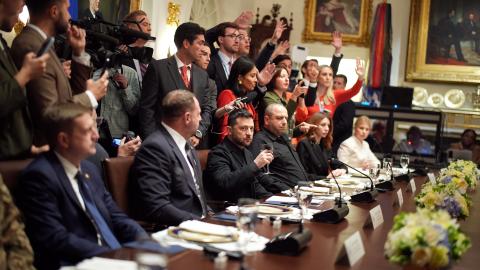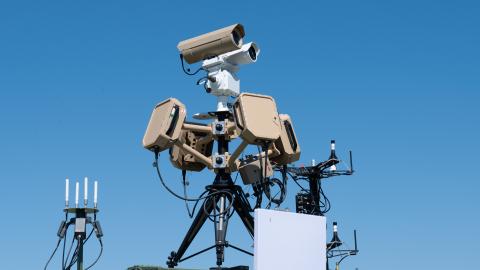When as many as two dozen Russian unmanned aerial vehicles (UAVs) entered Polish airspace on the night of September 9, European allies responded by scrambling perhaps the most sophisticated tactical defenses in the world. Italian airborne early warning and control aircraft (AEW&C), German Patriot air and missile defense batteries, Polish F-16s, 5th-generation Dutch F-35s, and a Belgian A330 MRTT tanker were all brought forth to track and engage the drones.
The next day, during her annual State of the Union address, European Commission President Ursula von der Leyen announced plans to build a European drone wall. “This is not an abstract ambition,” she noted. “It is the bedrock of credible defense.”
This announcement was certainly of the moment: deterrence against attacks like those of September 9 has frayed. Days after Russia’s drone incursion into Poland, another Russian drone breached allied airspace, this time over Romania. Unidentified drone sightings have since caused the temporary closure of several European airports, including Copenhagen, Oslo, and Munich. Last week, Belgium even reported that multiple drones had targeted Kleine Brogel, a military base which reportedly hosts US nuclear weapons.
Clearly, something must be done. But is an EU drone wall the right answer?
The EU’s “Drone Wall” Plan
At a meeting earlier this month, several EU leaders, especially from Europe’s Mediterranean south, expressed skepticism about the concept. Some even voiced outright opposition. France and Germany, military heavyweights who are loath to relinquish control over their national defense industries, oppose the initiative. NATO’s leaders in drone technology—Turkey, the UK, and the United States—do not belong to the EU at all.
To take on the challenges of drone warfare, the West will have to work together. However, it would be better to do so through NATO, utilizing a combination of both offensive and defensive measures. The danger is simply too great for Europe to operate within the strictures of the EU, which, by design, is not a military alliance.
It is a paradox of modern war that the low-tech drone has come to pose such a high risk to Western security. The price disparity between the offensive and defensive packages that clashed over Poland in early September illustrates this imbalance: the Russian drones that breached Polish airspace cost roughly $10,000 to produce, while the price tags of the craft that responded to them ran into the hundreds of millions of dollars.
The Gerbera drones that penetrated Polish airspace, for example, are a derivative of Iran’s Shahed family of UAVs. They are constructed primarily of plywood and foam. Because these drones are cheap, Russia is comfortable sacrificing large percentages of them—often up to 75 percent during attack salvos in Ukraine—merely to probe or saturate enemy defenses. Each Advanced Medium-Range Air-to-Air Missile (AMRAAM), which NATO used to intercept the Gerberas, costs roughly $1 million. A cheaper alternative, the Sidewinder missile, would still run in the hundreds of thousands of dollars. More importantly, Russia and Iran can produce thousands of drones per month, while NATO-standard interceptors cannot be easily replaced.
The low per-unit cost of Shahed drones has also made it easy for Russia to modify and improve its UAVs. Wreckage assessments from Ukraine have revealed Shahed variants with thermobaric warheads and even turbojets that can inflict greater damage and travel faster than ever before. New anti-jamming UAVs, like the Shahed-149, are tailor-made for today’s electronic warfare-saturated environment.
To be successful against such DIY munitions, a properly designed drone wall must employ advanced and costly interceptors, from anti-aircraft gun teams and fixed-wing fighter aircraft to rotary-wing platforms, surface-to-air missiles, electronic warfare assets, and drone-hunting drones, an increasingly common fixture of the war in Ukraine. To ensure a rapid response to any Russian drone incursions, these technologies would require artificial intelligence systems capable of processing substantial data feeds from space-based assets, legacy radars, and acoustic sensors.
It is difficult to imagine the EU developing the multinational command system and warfighting capabilities necessary to deliver this complex battle network in the near future. Even von der Leyen acknowledged such a challenge during her State of the Union address, when she argued that Europe “must invest in real-time space surveillance so that no movement of forces goes unseen.”
Ukraine’s “Sky Fortress”
Ukraine’s Sky Fortress anti-drone architecture reveals just how complex the effort to combat Russian drones can be—and demonstrates how to do so with a modicum of success. Kyiv’s system uses thousands of acoustic sensors linked to distributed processing nodes that employ machine-learning models to classify airborne threats.
Sky Fortress has proven effective even when Russia has altered the acoustic signatures of its munitions. After capturing the new signatures, Ukrainian engineers quickly retrain their models to respond to them. Ukraine’s Mobile Firing Groups also provide maneuverable air-defense elements to react to emerging threats. As a result, Ukraine’s anti-drone system has witnessed only a small drop in efficacy as Russia has modified its weapons.
Despite the best efforts of Brussels, the EU’s bureaucracy and lack of warfighting experience make it unlikely that it can field and deploy its own version of Sky Fortress anytime soon. And purely defensive measures may not be enough for Europe. Drone warfare is an offense-dominant regime, and even the sturdiest drone wall will inevitably have its weak points. Rather than rely purely on interception, which will prove difficult even in response to limited incursions, Europe, with American support, should assist Ukraine in hitting Russia’s drone launch positions and drone production facilities.
Since the summer, Russia has launched, on average, over 5,000 Shahed drones per month; not a single day goes by without a drone over Ukrainian skies. Moreover, Russia is expanding its principal drone plant in Alabuga and standing up other such facilities, including one in Izhevsk. Next year, Russia will aim to launch up to 10,000 drones per month.
Kyiv is developing long-range strike capabilities to target these facilities, such as the Flamingo missile and FP-1 drone. Moreover, several of Russia’s 15 launch positions are in close proximity to Ukraine, including three drone-strike nests in occupied Crimea. Hitting those positions preemptively could be accomplished with shorter-range systems, like air-launched cruise missiles and tactical ballistic missiles.
NATO Is Better Suited for Drone Defense
The West could also do more to support Ukraine’s deep-strike capabilities. To be sure, such a step may spur Russia to increase its hybrid campaign in retaliation. However, helping Ukraine in this effort would impose costs on Russia for its misbehavior, slow the production of one of Moscow’s most important military assets, and could strengthen Ukraine’s hand at a time of great difficulty.
Such a decision cannot and will not be taken in the European Quarter of Brussels, however. While NATO’s response to Russia’s drone incursion into Poland followed an imperfect script, it nonetheless reflected a plan. Moreover, through the Supreme Allied Commander Europe (SACEUR), NATO is the only alliance that possesses an established military command with the capabilities and a clear mandate to defend allied territory. While the EU is at the start of its debate over a drone wall, NATO is already deploying forces under Operations Baltic Sentry and Eastern Sentry.
The challenge of Russian hybrid aggression is real—and precisely the type of problem for which NATO exists in the post-Cold War era. To duplicate NATO’s efforts through a multi-year EU initiative makes little sense. The North Atlantic Treaty Organization should take the lead in defending Europe from Russian drones and take a page from Ukraine’s playbook in the process.





















